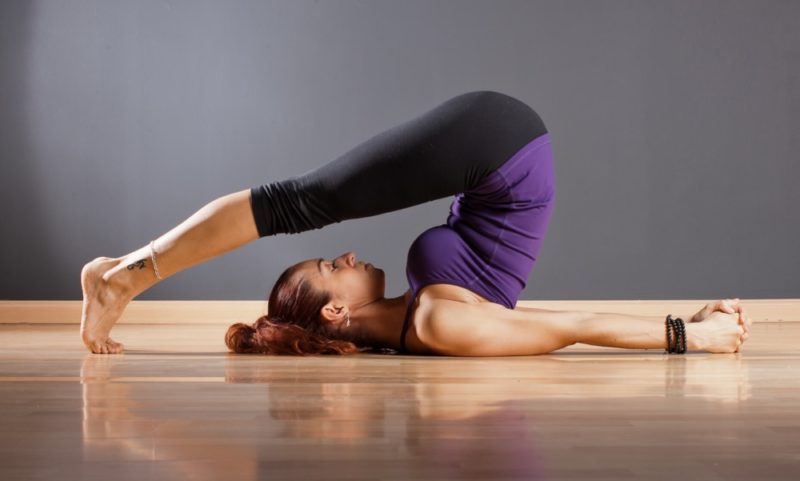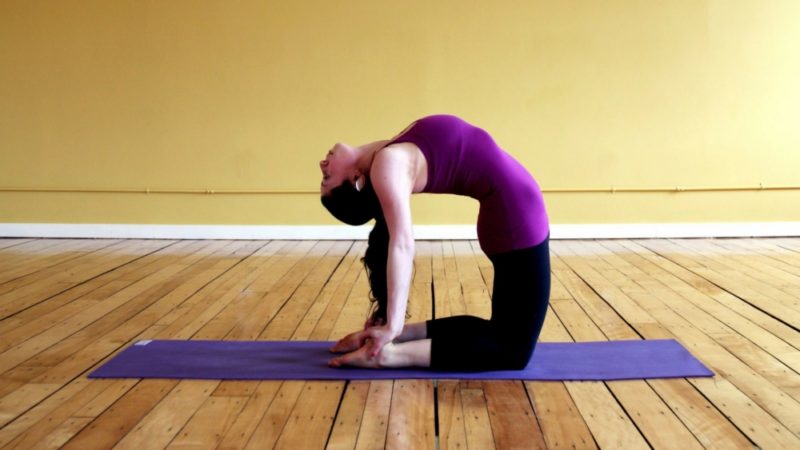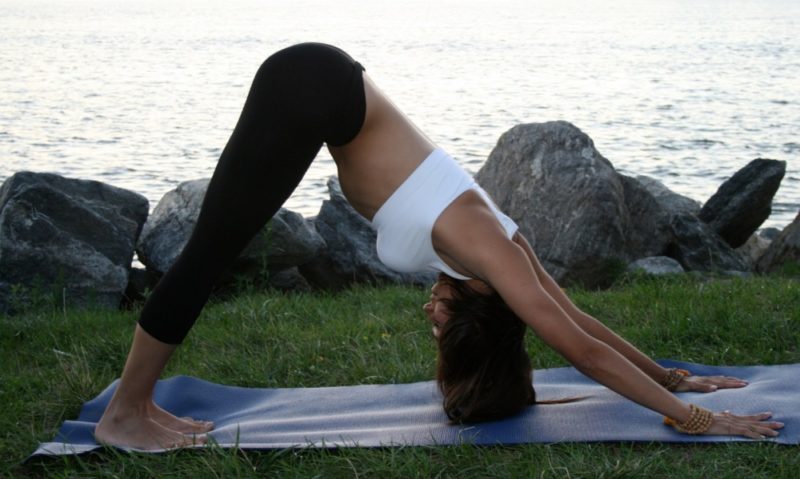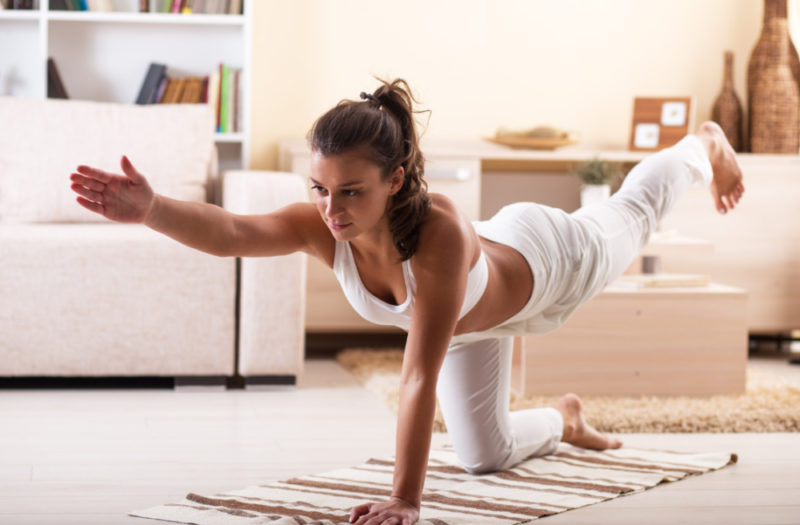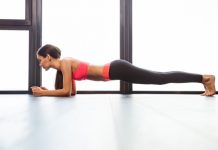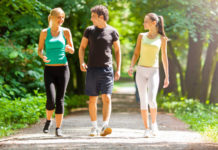The health of the spine - the main "pillar" that provides the muscles and the normal state of the departments of the human body, should be under constant and steady control. This is especially true for citizens, often forced to lead a sedentary lifestyle. Yoga for the back is a complex of physiotherapy exercises for everyone who has problems with the spine, not only can achieve physical health, but also find peace of mind and desired peace of mind.
Material Content:
The mechanism of the influence of yoga on the back and spine
Yoga classes have a positive effect on the spine and the body as a whole.
All exercises are based on long-term motionless retention of the body in a certain position. These special poses are called asanas. They should be performed daily to have a noticeable effect.
The effects of yoga can be divided into the following types:
- Physical For the most part, asanas involve muscles that are not well developed in everyday life. Taking non-standard body positions in the process of yoga, a person fully develops all groups of muscle tissue.
- Classes allow you to regulate vascular blood supply in them.
- Spiritual practice. The mental state of a person is largely able to influence the physical health of a person. Yoga classes help resolve the psychosomatic problems of the body and strengthen the spirit.
- Hormonal effect. Some postures during exercise are designed to stimulate and regulate the endocrine system.
- Energy impact.In the process of training, everyone is able to learn how to direct the energy of their own body in the required direction. These practices are aimed at providing the body with strength and energy.
A set of exercises performs two important functions for the health of the spine: strengthens the muscles of the back and stretches them.
Positive aspects of the impact of yoga:
- spinal stretching, increased flexibility;
- study of back muscles, which are even in places difficult to access for other types of exercises;
- muscle relaxation;
- stress relief and creating a positive attitude;
- improved posture, reduced curvature of the spine;
- additional mobility for the vertebrae;
- strengthening of the vascular walls;
- minimizing back pain.
Regular yoga classes can ease or even remove pain, add flexibility. A healthy back is the main goal of a unique physical education.
Indications for appointment
To improve the health of the body, the yoga classes presented are shown in the following cases:
- diseases of the spine in its various departments, which include scoliosis, kyphosis, intervertebral hernia (it is better to conduct classes with a trainer and after consulting a doctor), osteochondrosis and others;
- joint changes such as arthritis and arthrosis;
- vegetovascular dystonia;
- disturbances in the functioning of various body systems, such as digestive, sexual and others;
- feeling of constant fatigue;
- sleep disturbances;
- consequences of stress.
Yoga exercises allow you to achieve positive dynamics in the development of diseases, as well as almost completely rid a person of them.
How to prepare for training
For maximum effectiveness of the classes, you should adhere to certain recommendations before starting a workout:
- The best place for such exercises is a calm and secluded corner in the lap of nature. However, not everyone can afford to conduct daily classes in such a place. Therefore, an important condition for the effectiveness of asanas is the presence of fresh air. It is necessary to ventilate the room in which practical classes will be held.
- Light clothing made from natural fabrics should be preferred. At a fairly high temperature in the room, it is permissible to engage in a swimsuit. The main thing is that the clothes do not constrain movements and allow the skin to breathe.
- It is advisable to begin classes on an empty stomach, with an empty stomach and bladder. After a hearty dinner, it is better to refrain from such work for 3-4 hours.
- You should carefully consider the surface on which the lesson will be held. An individual place cannot be too hard or excessively soft. The ideal option is a special rug so that bruises and abrasions do not remain on the knees and elbows after taking the asanas. The bedding for yoga should be appropriate for the size of the human body.
- Before starting exercise, it is useful to take a shower, while choosing a water temperature that does not cause any discomfort or discomfort.
The implementation of these simple recommendations will achieve the desired result as soon as possible, and also create favorable conditions for the development of asanas.
Home exercises for beginners
Exercises for stretching the muscles of the back:
- Pavanmuktasana. Lie on your back, bend your legs at the knees and bring them to your stomach. With your hands grab your legs below the knees and press them firmly to your chest. In the process of taking the asana, you need to strain the abdominal muscles. Slowly and carefully do the rolls on the back in all directions. The exercise will be performed correctly, if during such movements a person manages to feel every vertebra.
- Apanasana. From the “supine” position, raise legs to the chest. The knees remain bent and the tailbone touches the floor. Hold this pose for 1 minute.
Yoga for osteochondrosis and other disorders of the motor functions of the body for home use:
- Cobra Pose. Lie on your stomach and relax. Wait 5-10 seconds.Place your palms on the floor, at shoulder level. Without straining the spine, slowly breathing in the air, raise the body with your head. For the best effect, you need to strain your hands.
- Cats Pose. Kneel down and try to relax. Tighten your toes, lean them on the floor surface. Inhaling the air slowly, lower the stomach and raise your head, looking up. Hold in this position for 2 seconds. On a leisurely exhale, bend your back and lower your head. Asanas should be done several times.
- Dog Pose. Get on your knees. Put your legs on your toes and slowly raise the pelvis, gradually straightening the limbs. Slowly straighten your back, taking small steps with your hands. In the process of performing an asana, you should try to put your feet on your foot completely. The head is pointing down. Hold this pose for no more than 40 seconds.
Yoga will be especially effective if you do not forget about proper breathing. Inhalations and exhalations should be carried out as slowly as possible and in accordance with the accepted position of the body.
Activities for children
Yoga classes are used to strengthen the muscles of the back and neck and develop love for your own body and in children.
A complex of simple and interesting asanas for classes with children:
- Frog. Feet set shoulder width apart. From this position, squat down and put your hands behind the back of your legs, placing your palms on the floor. Gradually shift your body weight forward, try to jump.
- Flamingo. Asan reminds everyone of the famous "swallow". Get up straight, arms hang freely, legs are brought together. Pull one lower limb back and at the same time tilt the body forward. Arms apart, helping them balance. Repeat the exercise with the other leg.
- Wood. Exercise is performed from a standing position, legs are brought together. Slowly place one foot on the knee joint of the other leg. Squeeze your palms, set them at chest level and slowly raise them above your head. Spend a few minutes in this position. Do not forget to change your leg.
- A boat. Sit on the floor, bend your knees, tear your feet off the mat and try to maintain balance in this position. As soon as it turns out, pick up the big toes and slowly straighten the limbs. Swing back and forth.
- Dog. Put your hands on the floor, legs on toes and bent at the knees, the pelvis is raised up. Slowly straighten your knees, resting your palms and trying to put your foot on a full foot.
- Candle. Lie on your back, bend your knees. Push your feet off the floor and move them behind your head so that your feet touch the floor. Hands remain in the starting position. The blades touch the floor. Slowly move your legs up to the birch position. Leisurely take the starting position.
- Bridge. Lying on the floor, bend your knees. Slowly lift the body up, arching the spine.
- Happy baby. The final relaxing pose. Lying on your back, bend your knees. Press them to your chest, grabbing your hands on the feet. Gently push your hands on the feet, pulling the hips down. Swing in different directions.
Regular yoga exercises will allow the child to better feel his body and develop back muscles evenly. And joint events can present many unforgettable moments.
What to do if your back hurts after yoga
If after practicing yoga in the muscles pain persists for two days, then there is no reason for concern. Most likely, the body undergoes adaptation to new loads for it.
When the pain persists for a longer time, you can resort to massage. In some cases, you can not neglect the need to consult a doctor to find out the cause of this condition.
Contraindications
Before starting the exercises, you need to familiarize yourself with the contraindications to yoga classes:
- migraine;
- psychological disorders;
- inguinal hernia;
- head injuries;
- vertebral trauma;
- infectious diseases of the joints;
- a stroke, during the first 6 months after an attack;
- malignant tumors;
- recently transferred operations;
- arthrosis of the joints;
- hypermobility in the joints;
- disturbances in the work of the heart;
- pregnancy;
- fever;
- menstruation;
- SARS.
It should be noted that old age is not an obstacle to performing a set of exercises. However, people over 60 years old, it is better to engage in such practices under the supervision of an experienced specialist. And also his help for the correct and safe performance of asanas will be required if there is an intervertebral hernia.
If any of the listed diseases is identified, yoga classes cannot be carried out. A strict ban is valid until appropriate therapy is carried out and the disease subsides.
Yoga for the spine and back can work wonders. Proper preparation, leisurely and calm execution of exercises, as well as the regularity of the approach, can eliminate the problems existing in this area, reduce or completely remove pain, and also improve the health of the body as a whole.


